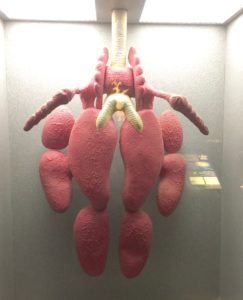The Biggest Makeover Ever! Dinosaur to Bird

Dromaeosaurs Illustration by Fred Wierum. http//:Wikimedia Commons
We tend to think that all dinosaurs became extinct about 65 million years ago. That’s when a large asteroid or comet (scientists don’t know which) hit the planet and triggered a global cataclysm of climate and temperature change, acid rain, earthquakes, tsunamis and wildfires. This event marked the end of the Cretaceous period. Though non-avian dinosaurs did become extinct, a clad of flying theropod relatives referred to as Aves, survived. These were the ancestors of today’s birds! The ability to fly enabled them to escape the worst conditions during that hellish time and survive (it is thought) on such things as seeds and other small omnivorous terrestrial and aquatic prey. So yes, the finch in your backyard is in fact a dinosaur!
Though it’s easy to dismiss a bird’s significance when we see its comparatively diminutive size today, let’s consider the millions of years and changes that occurred by chance during the late Jurassic and Cretaceous periods to make this transition. Let’s also be clear, it was not a straight line from dinosaur to bird. The process was chaotic and included bursts of evolutionary changes in species that did not make it. However, to be capable of aerodynamic flight these smaller theropods had to shrink in size and modify existing features that originally had other functions. Here are examples of some changes that occurred on the way to creating the blueprint of a bird.

A bird’s respiratory system includes many air sacks. Illustration provided by LA Museum of Natural History
Walking on only two feet was critical. Hollow bones were necessary to reduce weight, and also to accommodate air sacks. These sacks were part of a modified respiratory system that enable more efficient use of oxygen. One ovary was dropped—also in the interest of weight. Long forelimbs, a wishbone and quill-pen feathers made efficient and highly maneuverable flight possible, and expanded flight surface, just as birds have today. Quill-pen feathers also improved thermoregulation. Three-dimensional vision was enabled by larger eyes, and larger brains relative to body size improved navigation. Teeth were eventually lost to time. Why? It appears that teeth required a longer embryo period and therefore made eggs more vulnerable to predators. Another advantage may have been that retaining teeth required a heavier jaw which added weight. The loss of teeth drove some birds to a more diverse diet which helped to reduce competition. How’s that for a makeover!?
All ten thousand or more bird species living today are relatives of their flying cousins that escaped that extinction event. A look back at what made birds possible in the first place is a good step in appreciating the utter wonder of them!


Connect
Connect with us on the following social media platforms.